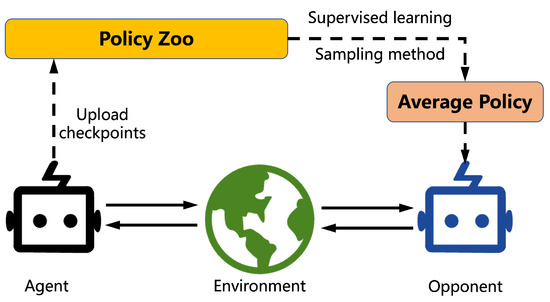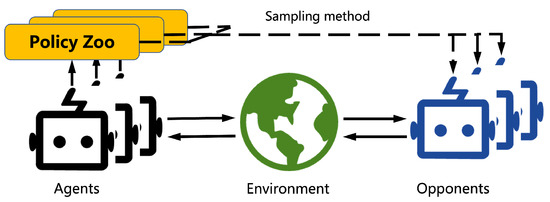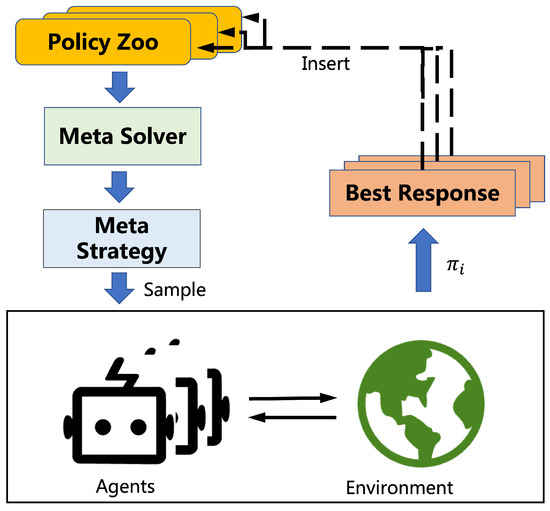
| Version | Summary | Created by | Modification | Content Size | Created at | Operation |
|---|---|---|---|---|---|---|
| 1 | Weifan Long | -- | 3203 | 2023-05-25 11:23:05 | | | |
| 2 | Jason Zhu | Meta information modification | 3203 | 2023-05-26 04:04:17 | | | | |
| 3 | Jason Zhu | Meta information modification | 3203 | 2023-06-15 05:38:34 | | |
Video Upload Options
Many real-world applications can be described as large-scale games of imperfect information, which require extensive prior domain knowledge, especially in competitive or human–AI cooperation settings. Population-based training methods have become a popular solution to learn robust policies without any prior knowledge, which can generalize to policies of other players or humans.
1. Introduction
2. Naive Self-Play
as a policy being trained, πzoo as a policy zoo, π′ as the policy set of the opponents, Ω as the policy sampling distribution, and G as the gating function for πzoo[2]. The policy sampling distribution Ω is
Since the policy zoo πzoo only keeps the latest version of policy π, it always clears the old policies πzoo and inserts π, πzoo=π.

3. Fictitious Self-Play

, was used for storing experience of game transitions, while the other, MSL, stored the best response behavior. Each agent computed an approximate best response β from MRL and updated its average policy Π by supervised learning from MSL. In principle, each agent could learn the best response by playing against the average policies of other agents. However, the agent cannot get its best response policy β, which is needed to train its average policy Π, and its average policy Π is needed for the best response training of other agents. NFSP uses the approximation of anticipatory dynamics of continuous-time dynamic fictitious play [11], in which players choose the best response to the short-term predicted average policy of their opponents, Π−it+ηddtΠt, where η is the anticipatory parameter. NFSP assumes βt+1−Πt≈ddtΠt as a discrete-time approximation. During play, all agents mixed their actions according to σ=Π+η(β−Π). By using this approach, each agent could learn an approximate best response with predicted average policies of its opponents. In other words, the policy sampling distribution of all agents Ω is
MRL uses a circular buffer to store transition in every step, but MSL only inserts transition while agent follows the best response policy β.
where Qb(S) is the expected return at state S with joint policy set b, Pℓ2 is the L2 projection, ∇θSπθt−1(S) is an identity matrix, and α is the step size. In other words, the ED algorithm directly optimizes policies against worst-case opponents, making it a promising approach for addressing games with complex strategy spaces.
Significantly, the algorithm is the same as naive SP while δ=1. After every episode, the training policy is always inserted into the policy zoo πzoo. Thus, πzoo is updated with πzoo=πzoo∪π.
where f is a weighting function, e.g., f(x)=(1−x)p. The policy zoo named league in the paper is complex.
4. Population-Play

5. Evolution-Based Training Methods
6. General Framework

where n=|πzoo|, ϕ(x,y) is the payoff function, p is the Nash equilibrium on πzoo, ⌊x⌋+ is the rectifier, denoted by ⌊x⌋+=x if x≤0 and ⌊x⌋+=0 otherwise. Equation (7) encourages agents to play against opponents who they can beat. Perhaps surprisingly, the authors found that building objectives around the weaknesses of agents does not actually encourage diverse skills. To elaborate, when the weaknesses of an agent are emphasized during training, the gradients that guide its policy updates will be biased towards improving those weaknesses, potentially leading to overfitting to a narrow subset of the state space. This can result in a lack of diversity in the learned policies and a failure to generalize to novel situations. Several other works have also focused on the diversity aspect of PSRO frameworks. In [28], the authors propose a geometric interpretation of behavioral diversity in games (Diverse PSRO) and introduce a novel diversity metric that uses determinantal point process (DPP). The diversity metric is based on the expected cardinality of random samples from a DPP in which the ground set is the strategy population. It is denoted as:
where a DPP defines a probability P, π′ is a random subset drawn from the DPP, and Lπzoo is the DPP kernel. They incorporate this diversity metric into best-response dynamics to improve overall diversity. Similarly, [29] notes the absence of widely accepted definitions for diversity and offers a redefined behavioral diversity measure. The authors propose response diversity as another way to characterize diversity through the response of policies when facing different opponents.
References
- Al, S. Some studies in machine learning using the game of checkers. IBM J. Res. Dev. 1959, 3, 210–229.
- Hernandez, D.; Denamganai, K.; Devlin, S.; Samothrakis, S.; Walker, J.A. A comparison of self-play algorithms under a generalized framework. IEEE Trans. Games 2021, 14, 221–231.
- Tesauro, G. TD-Gammon, a self-teaching backgammon program, achieves master-level play. Neural Comput. 1994, 6, 215–219.
- Silver, D.; Huang, A.; Maddison, C.J.; Guez, A.; Sifre, L.; Van Den Driessche, G.; Schrittwieser, J.; Antonoglou, I.; Panneershelvam, V.; Lanctot, M.; et al. Mastering the game of Go with deep neural networks and tree search. Nature 2016, 529, 484–489.
- Silver, D.; Schrittwieser, J.; Simonyan, K.; Antonoglou, I.; Huang, A.; Guez, A.; Hubert, T.; Baker, L.; Lai, M.; Bolton, A.; et al. Mastering the game of go without human knowledge. Nature 2017, 550, 354–359.
- Ye, D.; Chen, G.; Zhao, P.; Qiu, F.; Yuan, B.; Zhang, W.; Chen, S.; Sun, M.; Li, X.; Li, S.; et al. Supervised learning achieves human-level performance in moba games: A case study of honor of kings. IEEE Trans. Neural Netw. Learn. Syst. 2020, 33, 908–918.
- Baker, B.; Kanitscheider, I.; Markov, T.; Wu, Y.; Powell, G.; McGrew, B.; Mordatch, I. Emergent Tool Use From Multi-Agent Autocurricula. In Proceedings of the International Conference on Learning Representations, Addis Ababa, Ethiopia, 26–30 April 2020.
- Brown, G.W. Iterative solution of games by fictitious play. Act. Anal. Prod. Alloc. 1951, 13, 374.
- Heinrich, J.; Lanctot, M.; Silver, D. Fictitious self-play in extensive-form games. In International Conference on Machine Learning; PMLR: Cambridge, MA, USA, 2015; pp. 805–813.
- Heinrich, J.; Silver, D. Deep reinforcement learning from self-play in imperfect-information games. arXiv 2016, arXiv:1603.01121.
- Shamma, J.S.; Arslan, G. Dynamic fictitious play, dynamic gradient play, and distributed convergence to Nash equilibria. IEEE Trans. Autom. Control 2005, 50, 312–327.
- Lockhart, E.; Lanctot, M.; Pérolat, J.; Lespiau, J.; Morrill, D.; Timbers, F.; Tuyls, K. Computing Approximate Equilibria in Sequential Adversarial Games by Exploitability Descent. In Proceedings of the Twenty-Eighth International Joint Conference on Artificial Intelligence, IJCAI 2019, Macao, China, 10–16 August 2019; Kraus, S., Ed.; pp. 464–470.
- Bansal, T.; Pachocki, J.; Sidor, S.; Sutskever, I.; Mordatch, I. Emergent Complexity via Multi-Agent Competition. In Proceedings of the International Conference on Learning Representations, Vancouver, BC, Canada, 30 April–3 May 2018.
- Vinyals, O.; Babuschkin, I.; Czarnecki, W.M.; Mathieu, M.; Dudzik, A.; Chung, J.; Choi, D.H.; Powell, R.; Ewalds, T.; Georgiev, P.; et al. Grandmaster level in StarCraft II using multi-agent reinforcement learning. Nature 2019, 575, 350–354.
- Berner, C.; Brockman, G.; Chan, B.; Cheung, V.; Debiak, P.; Dennison, C.; Farhi, D.; Fischer, Q.; Hashme, S.; Hesse, C.; et al. Dota 2 with Large Scale Deep Reinforcement Learning. arXiv 2019, arXiv:1912.06680.
- Jaderberg, M.; Czarnecki, W.M.; Dunning, I.; Marris, L.; Lever, G.; Castaneda, A.G.; Beattie, C.; Rabinowitz, N.C.; Morcos, A.S.; Ruderman, A.; et al. Human-level performance in 3D multiplayer games with population-based reinforcement learning. Science 2019, 364, 859–865.
- Siu, H.C.; Peña, J.; Chen, E.; Zhou, Y.; Lopez, V.; Palko, K.; Chang, K.; Allen, R. Evaluation of Human-AI Teams for Learned and Rule-Based Agents in Hanabi. In Advances in Neural Information Processing Systems; Ranzato, M., Beygelzimer, A., Dauphin, Y., Liang, P., Vaughan, J.W., Eds.; Curran Associates, Inc.: Red Hook, NY, USA, 2021; Volume 34, pp. 16183–16195.
- Strouse, D.; McKee, K.; Botvinick, M.; Hughes, E.; Everett, R. Collaborating with humans without human data. Adv. Neural Inf. Process. Syst. 2021, 34, 14502–14515.
- Yu, C.; Gao, J.; Liu, W.; Xu, B.; Tang, H.; Yang, J.; Wang, Y.; Wu, Y. Learning Zero-Shot Cooperation with Humans, Assuming Humans Are Biased. arXiv 2023, arXiv:2302.01605.
- He, J.Z.Y.; Erickson, Z.; Brown, D.S.; Raghunathan, A.; Dragan, A. Learning Representations that Enable Generalization in Assistive Tasks. In Proceedings of the 6th Annual Conference on Robot Learning, Auckland, New Zealand, 14–18 December 2022.
- Jaderberg, M.; Dalibard, V.; Osindero, S.; Czarnecki, W.M.; Donahue, J.; Razavi, A.; Vinyals, O.; Green, T.; Dunning, I.; Simonyan, K.; et al. Population Based Training of Neural Networks. arXiv 2017, arXiv:1711.09846v2.
- Majumdar, S.; Khadka, S.; Miret, S.; Mcaleer, S.; Tumer, K. Evolutionary Reinforcement Learning for Sample-Efficient Multiagent Coordination. In 37th International Conference on Machine Learning; Daumé, H., Singh, A., Eds.; PMLR: Cambridge, MA, USA, 2020; Volume 119, pp. 6651–6660.
- Khadka, S.; Majumdar, S.; Nassar, T.; Dwiel, Z.; Tumer, E.; Miret, S.; Liu, Y.; Tumer, K. Collaborative Evolutionary Reinforcement Learning. In 36th International Conference on Machine Learning; Chaudhuri, K., Salakhutdinov, R., Eds.; PMLR: Cambridge, MA, USA, 2019; Volume 97, pp. 3341–3350.
- Gupta, A.; Savarese, S.; Ganguli, S.; Fei-Fei, L. Embodied intelligence via learning and evolution. Nat. Commun. 2021, 12, 5721.
- Liu, S.; Lever, G.; Merel, J.; Tunyasuvunakool, S.; Heess, N.; Graepel, T. Emergent Coordination Through Competition. In Proceedings of the 7th International Conference on Learning Representations, ICLR 2019, New Orleans, LA, USA, 6–9 May 2019.
- Lanctot, M.; Zambaldi, V.F.; Gruslys, A.; Lazaridou, A.; Tuyls, K.; Pérolat, J.; Silver, D.; Graepel, T. A Unified Game-Theoretic Approach to Multiagent Reinforcement Learning. In Proceedings of the Advances in Neural Information Processing Systems 30: Annual Conference on Neural Information Processing Systems 2017, Long Beach, CA, USA, 4–9 December 2017; Guyon, I., von Luxburg, U., Bengio, S., Wallach, H.M., Fergus, R., Vishwanathan, S.V.N., Garnett, R., Eds.; Curran Associates Inc.: Red Hook, NY, USA, 2017; pp. 4190–4203.
- Balduzzi, D.; Garnelo, M.; Bachrach, Y.; Czarnecki, W.; Perolat, J.; Jaderberg, M.; Graepel, T. Open-ended learning in symmetric zero-sum games. In International Conference on Machine Learning; PMLR: Cambridge, MA, USA, 2019; pp. 434–443.
- Perez-Nieves, N.; Yang, Y.; Slumbers, O.; Mguni, D.H.; Wen, Y.; Wang, J. Modelling behavioural diversity for learning in open-ended games. In International Conference on Machine Learning; PMLR: Cambridge, MA, USA, 2021; pp. 8514–8524.
- Liu, X.; Jia, H.; Wen, Y.; Hu, Y.; Chen, Y.; Fan, C.; Hu, Z.; Yang, Y. Towards unifying behavioral and response diversity for open-ended learning in zero-sum games. Adv. Neural Inf. Process. Syst. 2021, 34, 941–952.
- McAleer, S.; Lanier, J.B.; Fox, R.; Baldi, P. Pipeline psro: A scalable approach for finding approximate nash equilibria in large games. Adv. Neural Inf. Process. Syst. 2020, 33, 20238–20248.
- Zhou, M.; Chen, J.; Wen, Y.; Zhang, W.; Yang, Y.; Yu, Y. Efficient Policy Space Response Oracles. arXiv 2022, arXiv:2202.0063v4.
- Muller, P.; Omidshafiei, S.; Rowland, M.; Tuyls, K.; Perolat, J.; Liu, S.; Hennes, D.; Marris, L.; Lanctot, M.; Hughes, E.; et al. A Generalized Training Approach for Multiagent Learning. In Proceedings of the International Conference on Learning Representations, Addis Ababa, Ethiopia, 26–30 April 2020.
- Omidshafiei, S.; Papadimitriou, C.; Piliouras, G.; Tuyls, K.; Rowland, M.; Lespiau, J.B.; Czarnecki, W.M.; Lanctot, M.; Perolat, J.; Munos, R. α-rank: Multi-agent evaluation by evolution. Sci. Rep. 2019, 9, 9937.
- Marris, L.; Muller, P.; Lanctot, M.; Tuyls, K.; Graepel, T. Multi-agent training beyond zero-sum with correlated equilibrium meta-solvers. In International Conference on Machine Learning; PMLR: Cambridge, MA, USA, 2021; pp. 7480–7491.
- Muller, P.; Rowland, M.; Elie, R.; Piliouras, G.; Pérolat, J.; Laurière, M.; Marinier, R.; Pietquin, O.; Tuyls, K. Learning Equilibria in Mean-Field Games: Introducing Mean-Field PSRO. In Proceedings of the 21st International Conference on Autonomous Agents and Multiagent Systems, AAMAS 2022, Auckland, New Zealand, 9–13 May 2022; Faliszewski, P., Mascardi, V., Pelachaud, C., Taylor, M.E., Eds.; International Foundation for Autonomous Agents and Multiagent Systems (IFAAMAS), 2022; pp. 926–934.




